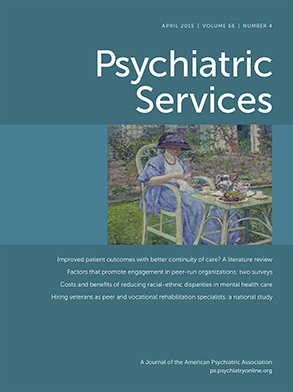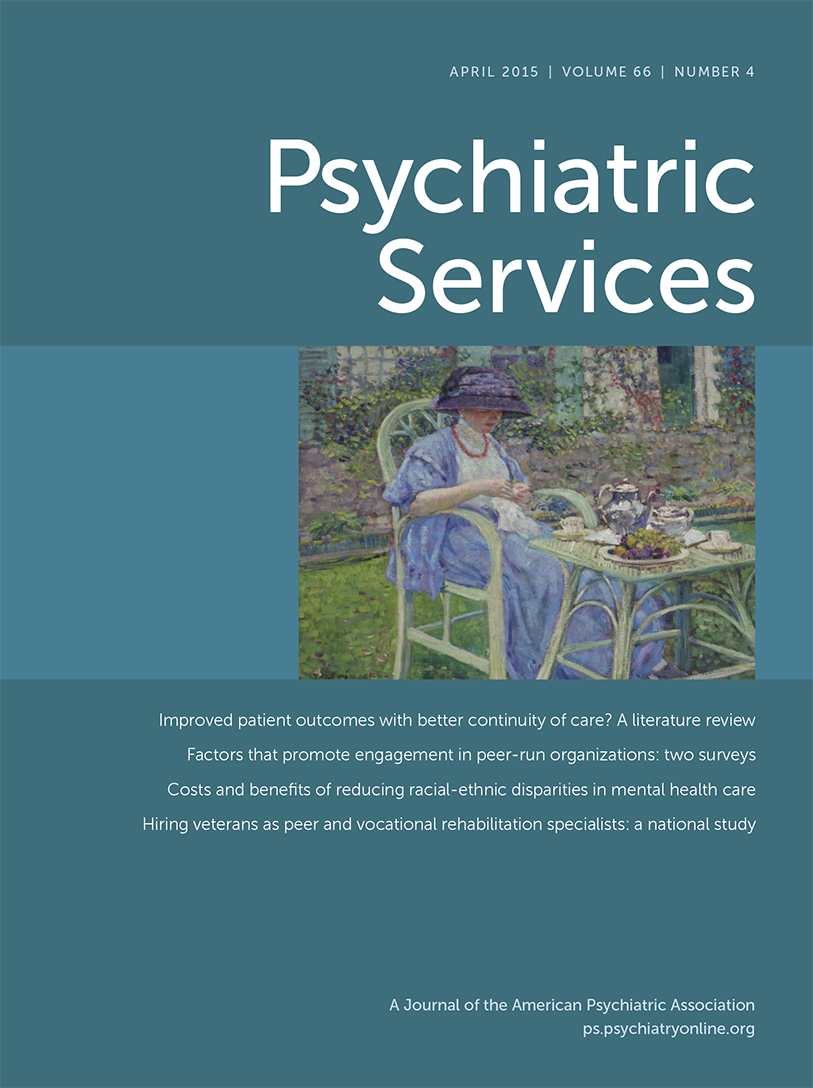The Affordable Care Act (ACA) is expected to provide insurance coverage to 25 million individuals who were previously uninsured (
1). The legislation allows states to expand Medicaid to individuals who were previously ineligible, such as single adults without documented disabilities. It also provides tax credits to individuals who purchase private insurance through the health insurance marketplace when they lack access to affordable employer-sponsored coverage. Currently, 26 states and the District of Columbia have decided to expand their Medicaid programs. If more states decide to participate, the number of people gaining coverage will increase. Individuals who gain coverage are expected to experience improved access to high-quality behavioral health services (
2–
4).
Policy makers need accurate data on the prevalence of mental and substance use disorders and on the potential demand for behavioral health services among those who may gain coverage as a result of the ACA. Garfield and colleagues (
5) analyzed data from the Medical Expenditure Panel Survey. They found that among uninsured adults ages 18–64 years with incomes of less than 133% of the federal poverty level (FPL), 18.8%−29.5% had probable depression and 19.1%−29.9% had serious psychological distress. Among individuals with severe mental disorders, 21.5% of those who lacked insurance coverage for the full year used any mental health service, compared with 48.4% of those with Medicaid insurance. The authors estimated that reform will lead to a net increase of 1.15 million mental health care users.
Busch and colleagues (
6) used data from the National Survey on Drug Use and Health (NSDUH) to describe use of treatment for substance use disorders among individuals who may be eligible for Medicaid as a result of the ACA. They found that 14.6% of uninsured individuals with incomes less than 138% of FPL had substance dependence or abuse, a slightly higher rate than among current Medicaid recipients (11.5%). Among future Medicaid-eligible individuals in need of treatment for a substance abuse disorder, only 12.8% received formal treatment, compared with 30.7% of current Medicaid enrollees.
Although results of these studies are extremely useful, they have limitations. They do not indicate, for example, the percentage of individuals who are likely to enroll under the Medicaid expansion who will use specific types of mental health services. Lack of this type of information has been problematic in other, more limited efforts to expand access to health care insurance.
To help states plan for the behavioral health services needs associated with implementation of the ACA, we collaborated with the Substance Abuse and Mental Health Services Administration (SAMHSA) to create the
Behavioral Health Treatment Needs Assessment Toolkit for States (
7,
8). This document gives state policy makers, payers, and others information about the prevalence and use of behavioral health services; step-by-step instructions for generating projections of utilization under insurance expansions; and factors to consider when determining the appropriate mix of behavioral health benefits, services, and providers necessary to meet the needs of newly eligible populations.
In this report, we summarize and update the analyses published in the Behavioral Health Treatment Needs Assessment Toolkit for States, making the data available to a wider audience, and describe the analyses’ key implications.
Methods
We used pooled data from adults ages 18 through 64 years who responded to the 2008–2011 NSDUH. The NSDUH is an annual survey sponsored by SAMHSA (
www.samhsa.gov/data/NSDUH.aspx). Interviewers collect data from a representative sample of the population by administering questionnaires about the previous year through face-to-face interviews at the respondents’ place of residence. To increase the estimates’ precision, we based estimates on data combined from multiple survey years. We adjusted the weights in the analysis to represent annual averages of the target population. Unidentified survey data are exempt from institutional review board approval.
We used the NSUDH data to calculate past-year prevalence rates for serious mental illness, any mental illness, and any substance use disorder. SAMHSA defines serious mental illness as having at least one mental disorder other than a developmental or substance use disorder in the past 12 months that resulted in serious impairment. Any mental illness is defined as a diagnosable mental, behavioral, or emotional disorder (excluding developmental and substance use disorders) of sufficient duration to meet DSM-IV diagnostic criteria during the year prior to the survey interview. Substance use disorder is defined as dependence on or abuse of alcohol or illicit drugs in the past year.
We examined past-year use of any mental health treatment, mental health inpatient facility, mental health outpatient facility, mental health prescription medication, substance abuse treatment, or substance abuse treatment facility.
We examined prevalence and utilization rates among all adults in the targeted age range nationwide and for three subsets: individuals who were currently enrolled in Medicaid; individuals who were uninsured and had incomes <139% of FPL, which captured the group likely eligible for Medicaid under the expansion; and individuals who were uninsured and had incomes between 133% and 399% of FPL, which captured the group eligible for insurance subsidies who were likely to purchase insurance in the health insurance marketplace. For the second subset, we used an income cutoff of <139% because the ACA extends Medicaid coverage to all individuals ages 19 through 64 years with incomes up to 133% of FPL and also includes a 5% income disregard, leading to an effective FPL of 138%. We used data from the 2011 American Community Survey to determine the size of the populations that fell within these categories (
www.census.gov/popest/data/historical/2010s/vintage_2011/index.html).
Results
Table 1 reports the 12-month prevalence estimates for serious mental illness, any mental illness, and substance use disorder, as well as the percentage of the population receiving different types of behavioral health treatment. The data reveal that approximately 5% of uninsured adults who may gain insurance coverage through Medicaid (5.4%) or the marketplace (4.7%) had a serious mental illness. This rate is significantly lower than the rate among current Medicaid beneficiaries with serious mental illness (9.6%). Approximately 21% of those who may gain insurance had any mental illness, regardless of the severity; this rate was also lower than the Medicaid rate of 30.5%.
Approximately 9% of individuals who may gain insurance used any mental health services. Most of these individuals used psychiatric medications (7.4%−7.5%), and less than 1% used inpatient mental health treatment. Uninsured adults who may gain insurance coverage under the ACA were slightly more likely than current Medicaid recipients to have a substance use disorder. Receipt of substance abuse treatment was very low across all populations, at 4.4% for individuals with current Medicaid insurance, 3.4% for uninsured individuals with incomes <139% of FPL, and 2.8% for uninsured individuals with incomes between 133% and 399% of FPL.
Discussion
Our analyses provided several contributions to the existing literature. First, we provided prevalence rates of serious mental illness by using a recently created NSDUH variable for that category. Prior NSDUH surveys and the Medical Expenditure Panel Survey report prevalence of serious psychological distress, which is based on responses to the Kessler 6 (
9). The new variable is based on the Kessler 6 and a measure of impairment, thus providing a more accurate measure of serious mental illness, which has been validated by clinical diagnostic interviews (
9). States are developing systems to track individuals in specialty or nonspecialty behavioral health service settings on the basis of severity of illness; therefore, the additional information provided in this analysis may be very useful in planning efforts (
10). For example, California projected that one to two million individuals would enroll in the state’s Medicaid expansion. Applying the 5.4% figure, California can anticipate that 54,000 to 108,000 of these new enrollees will have serious mental illness and may need specialized services.
The information we present on the prevalence of substance use disorders is similar to information presented by Busch and colleagues (
6), indicating that 14% of individuals who become eligible under the insurance expansion may have a substance use disorder. Strikingly, only 2.3% and 1.8% of individuals who may gain insurance under the Medicaid expansion and health insurance marketplace, respectively, may use substance abuse treatment in a specialty substance abuse facility. The rate of substance abuse facility treatment among current Medicaid recipients was also very low (3.4%). On the basis of these low rates, we conclude that if the Medicaid expansion programs provide substance abuse benefits and a service delivery system that are similar to or less robust than those provided by the current Medicaid system, states may continue to see very low rates of substance abuse specialty service use that are unlikely to fully address current needs.
Analyses of the effects of prior insurance expansions on substance abuse treatment were somewhat contradictory. A study of the Massachusetts insurance expansion found that among individuals who needed substance abuse treatment, enrollment in insurance and use of services were not as high as anticipated (
11). However, other analyses of Massachusetts, Vermont, and Maine data found significant increases in use of substance abuse treatment following insurance expansions (
12). The ACA is being implemented in concert with the Mental Health Parity and Substance Abuse Equity Act (MHPAEA). The MHPAEA may enhance the impact of expanded insurance by requiring that states offer robust substance abuse benefits on par with medical and surgical benefits across the full continuum of prevention, screening, outpatient, inpatient, and rehabilitative services (
13).
Although the data presented here identified the current rate of behavioral health service use among those who may gain insurance, they did not illustrate how that use may increase once individuals gain insurance. Insurance coverage is expected to increase utilization because insurance reduces the price of treatment to the individual. For example, the Centers for Medicare & Medicaid Services prepared an impact analysis of the ACA on the basis of research conducted in Oregon. They estimated that health care use and expenditures would increase by 25% as individuals move from being uninsured to insured (
14). One could apply these gross percentages to the data presented here. For example, our data indicate that about 7.5% of the 25 million individuals who are likely to gain insurance coverage as a result of the Medicaid expansion and health insurance marketplace will use psychiatric medication. Assuming a 25% increase in usage as a result of gaining insurance, the percentage using a psychiatric medication would increase to about 9.4%—from 1.9 million to 2.3 million individuals—an increase of .4 million individuals.
When using the estimates presented here, one should keep in mind that the NSDUH does not collect data from some groups of individuals who may gain coverage under the ACA, including individuals who are homeless but not living in a homeless shelter, active duty military personnel, and individuals housed in jails, prisons, or hospitals. The NSDUH also excludes comprehensive measures of behavioral health conditions and treatment among children.
Conclusions
The NSDUH offers important information on the likely need and demand for different categories of behavioral health services among individuals who may gain insurance under the ACA. The data presented here were reported on a national level. State-level estimates were also created as a part of this project and are available on SAMHSA’s Web site (
8).

